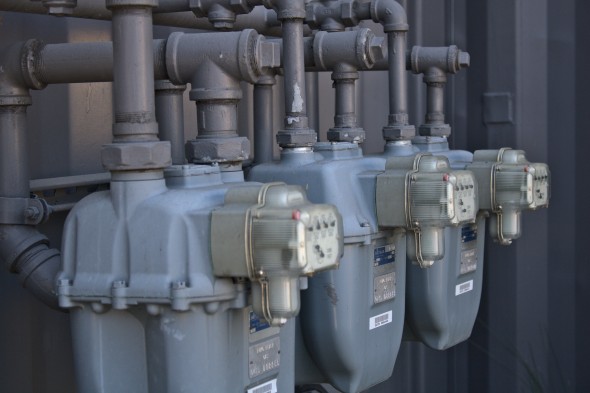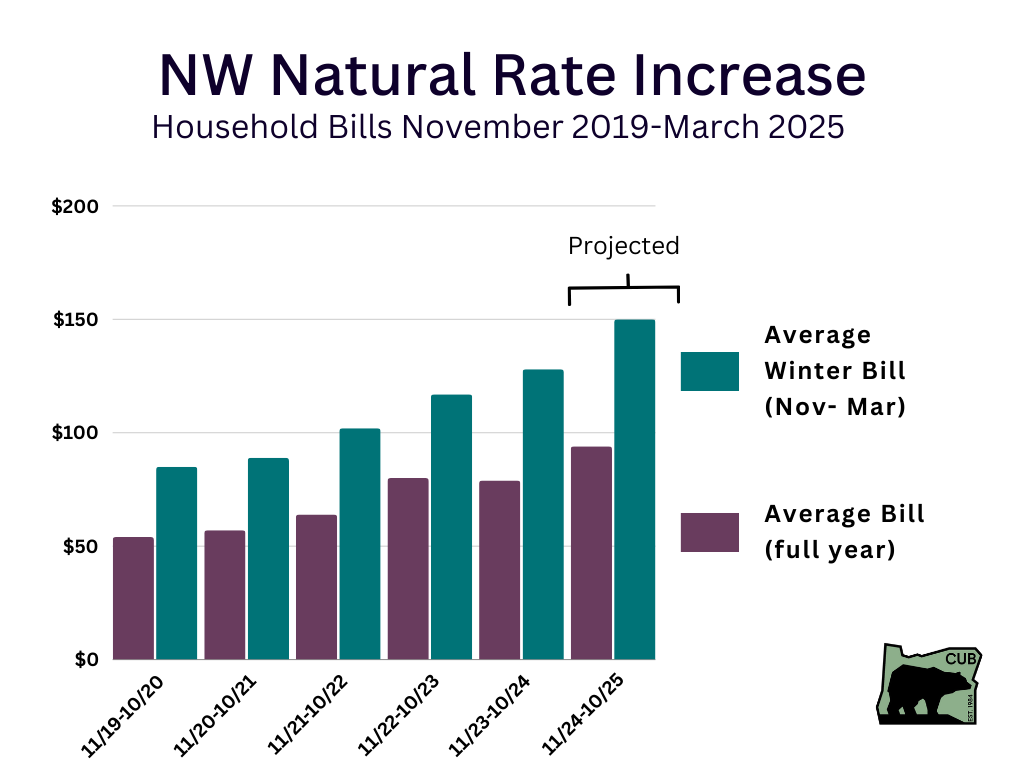NW Natural Asks for an 18% Rate Increase for Oregon Households
Posted on April 2, 2024 by Charlotte Shuff
Tags, Energy, General Interest

This year, NW Natural is asking to raise rates by 18% for residential customers. With the proposed increase, winter bills alone would go up $22.73 a month for an average household. Customers could face an average bill of $150 per month next winter. Overall, customers could see an increase of $169.68 per year.
CUB is pushing back to stop customers from seeing this request show up on bills this fall. We’re concerned with how NW Natural is spending customer money, particularly on buildings and system upgrades when inflation is driving up construction costs. We are also troubled to see that NW Natural is once again attempting to expand subsidies for growing its system (and its profits) at the expense of customers.
Customers Cannot Afford Another Increase in Gas Bills
NW Natural Homes Are Paying Nearly Double Than in 2020
Gas prices have skyrocketed over the past five years. In 2020, an average NW Natural household paid $550.52 per year in gas bills. In 2024, that number is expected to jump to $823.75. If this increase is approved, an average NW Natural home could pay $1122.82 in 2025—up nearly 100% since 2020.

Oregon’s other gas utilities have followed similar trends. Avista household bills are up 31% since 2020. Cascade homes’ bills are up 59% since 2020.
Much of these increases have come from the high cost of methane over recent years. However, we have seen fuel costs decrease over the last year. With these big swings in fuel costs, customers need more stability. An increase this large does not need to happen right now.
We Need a Cap on Rate Increases
Over the last four years, we have seen a troubling trend of utilities raising rates more often and in higher amounts. With utilities asking for multiple increases each year, it can be challenging to know how much of an increase customers are facing.
We saw this with PGE’s increase in January 2024. While PGE’s original ask was a rate increase of 14%, multiple requests ended up pushing rates up by 18%. The final numbers were not calculated until mid-December 2023 before showing up on customer bills on January 1, 2024. This trend extends to other electric customers, as well as customers of NW Natural and other gas utilities.
To combat this, CUB is proposing a new way of regulating how utilities can increase bills. CUB is proposing that the Oregon Public Utility Commission put a cap on rate increases. We are asking the Commission to limit rate increases to 7% plus inflation or 10%, whichever is lowest. This cap would apply to the cumulative increase customers see over the course of a year. Any requests over that cap would be pushed into the next year or beyond.
In normal circumstances, it should be rare for utilities to increase rates by more than 10%. Unfortunately, we have seen a growing pattern of Oregon’s for-profit utilities asking for 15-20% increases nearly every year for the last four years. This is a call to Oregon regulators for all for-profit utilities, not just NW Natural.
CUB is Pushing to Lower NW Natural’s Increase
While we are calling for regulators to cap this request at 10% for this fall, CUB is also working to lower the overall increase.
We’re investigating NW Natural’s claims for each issue outlined below (and more!). Over the next months, we will be submitting our analysis of what costs we think are reasonable to pass to customers—and what costs are unreasonable.
What’s Included in NW Natural’s Request
NW Natural is asking for $154.9 million, $110 million of which would be charged to Oregon households.
The gas utility’s $154.9 million request includes:
- Higher profit margins
- Expanding subsidies for growing the gas system
- Higher bills for customers in new gas buildings
- Changing accounting for how customers pay for large investments
- Infrastructure upgrades
Higher Profits
NW Natural is attempting to increase its profits by over a million per year. Regulators at the Oregon Public Utility Commission set how much profit utilities are allowed to make. NW Natural is asking to increase profit margins from 9.4% to 10.1%. In comparison, Oregon’s other for-profit utilities are currently allowed 9.4-9.5% returns.
Expanding Subsidies for Growing the Gas System
Existing customers pay for expanding NW Natural’s business through a subsidy called a “line extension allowance.” This subsidy is often paid to building developers, encouraging new homes to be built with gas.
In 2022, state regulators ordered that NW Natural must reduce the number of customer dollars it spends on expanding its gas system. That year, each new gas hookup cost customers $2875. Regulators required NW Natural to lower that amount each year, allowing only $1380 by the end of 2024.
NW Natural is now trying to increase the subsidy for growing its system to up to $3,600 per new building. This is a 25% increase from what regulators struck down not even two years ago. Expanding this subsidy could cost customers tens of millions per year.
CUB will continue to push back on these subsidies and encourage regulators to reduce them. In the face of climate regulation, it is not good for customers to pay for the gas utility to expand its system. More customers means more fossil fuel use and NW Natural has not shown how it can affordably reduce emissions.
Higher Costs for Customers in New Buildings
NW Natural is attempting to create a new billing structure where customers in buildings with new gas hookups pay almost 200% more than existing gas customers. With the proposed change, an existing customer pays a $10 flat fee for service. Meanwhile, a customer living in a building added to the gas system after November 2024 would pay a $26.25 flat fee for service.
If implemented, this would mean that moving to a new home could wildly increase the amount you are paying for gas. And this different rate would continue forever. Imagine five years from now moving to a home of the same size, using the same amount of gas, and having your gas bill double because someone this year decided to hook up to NW Natural’s system.
As Oregon sets out to build more housing across the state, this could pose a real threat to the affordability of living in new construction. Affordable housing projects are not excluded from this proposal, meaning low-income families could be paying the price for a housing developer’s choice to install a gas stove.
Because of the subsidy for new hookups outlined above, developers have a real incentive to install gas appliances. The combination of more money for new gas hookups and higher rates for those who live in these buildings is a disaster for customers. CUB will be fighting this proposal.
Changing Accounting for How Customers Pay for Large Investments
While a change in accounting may sound innocuous, this is actually one of the largest items in NW Natural’s request at about $34 million.
When a utility makes a big investment like a new power plant or upgrading a pipeline, customers don’t pay for it all at once. Instead, those millions of dollars are spread out over many years (and sometimes decades). But these new pipes or equipment have a limited lifespan before they need to be replaced again. So a pipeline upgrade costing $1 million could be only useful for 10 years but customers are paying for $50,000 over 20 years.
NW Natural is proposing a change that would limit the timeline for customers paying for new investments to the useful life of the infrastructure itself. This change would be applied to charges already in customers’ bills. Suddenly that $1 million pipeline needs to be paid off in 10 years instead of 20, raising bills in the short term.
While this accounting is generally something that CUB supports, the huge cost to customers in the short term is concerning.
Infrastructure Investments
NW Natural is proposing a number of infrastructure investments go into customers’ bills this year. While CUB understands that utilities need to make upgrades to keep the system running, we are unsure if these investments are reasonable.
It is worth noting that utilities can only make a profit off of new investments, so they have an incentive to spend more money on these items.
- Proposed investments include:
- Software upgrades ($21 million)
- Office building upgrades (estimated $13.3 million)
- Pipe replacement in the North Coast Feeder ($9 million)
CUB is looking into the software upgrades and building upgrades closely. We expect the pipe replacement to be a reasonable cost for providing safe and reliable service to customers.
Customers and Advocates Can Join the Process
While CUB is hard at work digging into NW Natural’s request, we cannot do this alone. This March, customers and advocates will have the opportunity to share their stories with regulators. Regulators must hear how an increase this large would impact real people.
Public Hearing
There will be a virtual public hearing:
6 pm - April 16, 2024
Join via Zoom
At these hearings, regulators at the Public Utility Commission will hold space for community members to weigh in. For more information on what to expect at these hearings, check out CUB’s blog: Speaking Up on Utility Issues: Public Comment Hearings
If you are interested in receiving updates and more information like testimony guides, you can sign up with CUB.
Written Comments
Whether or not you can make the public hearings, written comments can also go a long way. The Public Utility Commission is accepting public comments via email, phone, or mail now through April 24.
By email – .(JavaScript must be enabled to view this email address)
By Mail - Oregon Public Utility Commission, Attn: Public Comment, PO Box 1088, Salem OR 97308-1088
By Phone - at 503-378-6600 or 800-522-2404 or TTY 800-648-3458 on weekdays from 8 a.m. - 5 p.m.
Stay Up to Date on Oregon Utility Issues
CUB will continue to advocate for people in Oregon on major utility issues. Sign up for the CUB email list for the latest updates, action alerts, and news on policies that affect the utilities your home relies on.
To keep up with CUB, like us on Facebook and follow us on Twitter!




08/22/24 | 3 Comments | NW Natural Asks for an 18% Rate Increase for Oregon Households